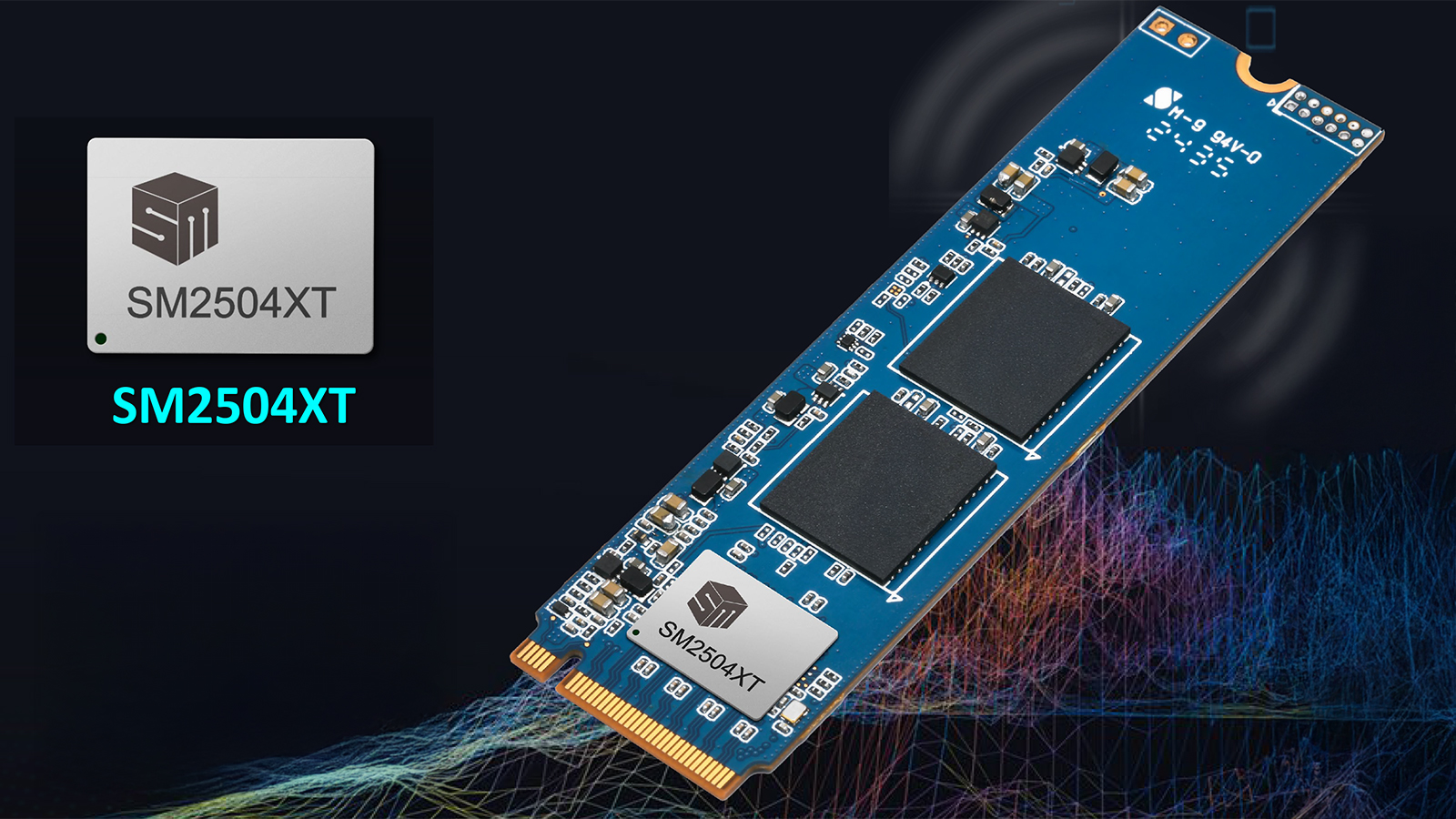PCIe 6.0 SSDs for PCs won't arrive until 2030 — costs and complexity mean PCIe 5.0 SSDs are here to stay for some time

PCIe 6.0 x4 SSDs for PCs, which would increase peak bandwidth to up to 32 GB/s, will not be available until 2030, according to Wallace C. Kuo, chief executive of Silicon Motion, a major independent developer of SSD controllers. In fact, neither AMD nor Intel is interested in enabling this capability soon, Kuo told Tom's Hardware in an exclusive interview.
"You will not see any PCIe Gen6 [solutions] until 2030," Kuo said. "PC OEMs have very little interest in PCIe 6.0 right now — they do not even want to talk about it. AMD and Intel do not want to talk about it."
The chief executive of Silicon Motion said that PCIe 6.0 SSDs for consumer PCs will not become a reality till 2030. Therefore, PCIe 5.0 x4 drives will probably remain the best SSDs to buy for your rig for quite a while.
Back in the day, GPUs and solid-state drives for enthusiast PCs would adopt new iterations of the PCIe interface almost immediately after the specification's release. However, the complexity of PCIe 6.0 implementation has slowed down its adoption by both enterprise and client applications.
Costs and the lack of interoperability tests by PCI-SIG (for now) are among the significant reasons behind not adopting the PCIe 6.0 interface for the client PC market.
As PCIe data rates increase, signal loss, noise, and impedance reduce the allowable copper trace length between the root complex and endpoints. At 16 GT/s (PCIe 4.0), traces can reach up to 11 inches with a 28 dB loss budget, but at 64 GT/s (PCIe 6.0), this drops to 3.4 inches with a 32 dB budget, depending on PCB materials and conditions, according to an Astera Labs presentation.
While such lengths and loss budget may suffice for SSDs in laptop PCs, especially assuming that they use low-loss materials for interconnections (which increases pricing), they may be inadequate for connecting graphics cards on an ATX motherboard, given their complexity nowadays, especially using now-common riser cards for enthusiast-grade PCs that enable placing graphics cards perpendicularly to the PC chassis for everyone to see.
On the data center market, PCIe 6.0 retimers are a straight solution to the issue, but they are too costly for the consumer PC market. Therefore, the client system industry will need to find a way to leverage the additional bandwidth enabled by the new PCIe iterations without relying on high-performance hardware. Without any doubt, it will get there. The only question is when.
Get Tom's Hardware's best news and in-depth reviews, straight to your inbox.
Follow Tom's Hardware on Google News to get our up-to-date news, analysis, and reviews in your feeds. Make sure to click the Follow button.

Anton Shilov is a contributing writer at Tom’s Hardware. Over the past couple of decades, he has covered everything from CPUs and GPUs to supercomputers and from modern process technologies and latest fab tools to high-tech industry trends.
-
micheal_15 According to "news sources" PCI-E 4.0 won't be available until 2028 at the earliest....and pci-e 5 hardware MIGHT be available to enthusiasts by 2030.....Reply
This smacks of saying "just spend money NOW, don't hold onto it". I wonder who would benefit from buying a journalist/reviewer to say this? -
newtechldtech PCIe 6.0 SSD should come fast and use 2 lanes instead of four ... we dont have enough lanes from non server grade CPUs...Reply -
bit_user I'd say PCIe 4.0 arrived about on time. It came to consumer platforms 7 years after PCIe 3.0. NVMe SSDs were just starting to near the limits of PCIe 3.0, as were GPUs.Reply
When PCIe 4.0 hit, it took SSDs more than a year to actually show a decent improvement from using it! Even high-end GPUs using PCIe 4.0 showed maybe a couple % benefit. Even GPUs as powerful as the RTX 4090 were no exception.
Source: https://www.techpowerup.com/review/nvidia-geforce-rtx-4090-pci-express-scaling/28.html
When you look at 1% minimums, the assessment doesn't change much. Here's data from their testing of the RTX 5090 on PCIe 5.0:
Source: https://www.techpowerup.com/review/nvidia-geforce-rtx-5090-pci-express-scaling/32.html
If you compare the PCIe 4.0 and 3.0 speeds, in that graph, 4.0 is a whopping 2.6% faster that PCIe than 3.0!
: D
I think we can safely say that PCIe 5.0 was not and is not necessary, on consumer machines!
PCIe 4.0 arguably solves the problem of making it viable to use x8 or x4 lanes for a dGPU (depending on the performance tier), either because the manufacturer cut the lane count, or because you want to use another PCIe slot or two. However, we should consider that newer PCIe standards require more silicon die area for the PCIe controller, which makes this reduction of lane count a somewhat self-fulfilling prophesy.
The only reason I think we got PCIe 5.0 as soon as we did is that Intel was feeling butt-hurt from getting spanked by AMD and thought they'd up the ante. It's pure specsmanship. It's funny to me how, until this year, there were no consumer PCIe 5.0 add-in-cards. The only place consumers were using PCIe 5.0 was in the M.2 slots, which Intel ironically didn't even support until Arrow Lake. ...and the irony doesn't stop there, as Arrow Lake has its own PCIe issues!
https://www.tomshardware.com/pc-components/cpus/intel-arrow-lake-processors-bottleneck-pcie-5-0-nvme-ssds-by-16-percent-limiting-peak-speeds-to-12gb-s-instead-of-14gb-s
In fact, I'd go so far as to say that the only reason RTX 5000 even supports PCIe 5.0 is for AI! And AMD just added it to try and match Nvidia. Neither of them needed it, for gaming purposes.
If we extrapolate from what happened with PCIe 3.0 -> 4.0, I'd say we shouldn't have had PCIe 5.0 until next year. That would push PCIe 6.0 out to 2033. Using the figure of 2030 puts us roughly half-way in between a 7 year follow-on from the actual introduction of PCIe 5.0 and where it should've been. Sounds okay to me.
Then again, it's hard to know exactly what the computing world will look like, in 5 years. Maybe CPUs will all have on-package memory, by then, and CXL memory expansions will be all the rage. That would create a new need for faster PCIe/CXL speeds, and PCIe 6.0 / CXL 3.0 would be the antidote. It'll be interesting to watch. -
bit_user Reply
IMO, the only thing they need to upgrade is the PCIe speed between the CPU and chipset. Right now, it's 4.0 for both Intel and AMD, though Intel uses x8 and AMD uses only x4. So, AMD needs to do this more than Intel, but I wouldn't mind seeing them both do it, since it's the one place where PCIe 5.0 could have the greatest impact, today.newtechldtech said:PCIe 6.0 SSD should come fast and use 2 lanes instead of four ... we dont have enough lanes from non server grade CPUs...
With dGPUs using ever greater amounts of power, it's actually kind of hard to find a dGPU that uses only 2 slots. From what I've seen, most of them use at least 2.5 slots, at the midrange tier and above. So, you don't even have very many PCIe slots available, in a decently-powered desktop. Go ahead and run your dGPU at PCIe 5.0 x8 (you'll never notice the difference!). That will give you another x8 or two x4 slots that are CPU-connected. Then, if the chipset is PCIe 5.0-connected, that's enough for anything else you'd care to plug in.
Also, don't forget the "sticker shock" people had over motherboard prices, when PCIe 5.0 and DDR5 first hit the market. As the article says, PCIe 6.0 is going to ratchet up board costs yet again. Pushing higher data rates isn't free, at this point. The need for better signal-to-noise ratios will require more PCB layers and more expensive materials. Node shrinks won't nullify this, either. -
bit_user Reply
BTW, you didn't mention anything about power or the additional silicon area required by the newer PCIe standard. 6.0 has new features that, along with its modulation scheme, should significantly increase the die area required for PCIe controllers.The article said:As PCIe data rates increase, signal loss, noise, and impedance reduce the allowable copper trace length between the root complex and endpoints. At 16 GT/s (PCIe 4.0), traces can reach up to 11 inches with a 28 dB loss budget, but at 64 GT/s (PCIe 6.0), this drops to 3.4 inches with a 32 dB budget, depending on PCB materials and conditions, according to an Astera Labs presentation.
If you add up all the area for the PCIe PHYs, buffers, etc. across both Arrow Lake's I/O die and SoC die, it looks to me like about the same area as 3 P-cores!
Source: https://www.techpowerup.com/336412/inside-arrow-lake-intels-die-exposed-and-annotated#g336412-4Granted, they use a larger node, but stil... that's just PCIe 4.0 and 5.0. It'll be even worse, when you look at 6.0 and add in the additional CXL protocol support that I'm sure we'll have by then. -
bit_user Reply
This is something that came to light during an interview with the CEO of a company that designs SSD controllers. So, it's from a good source.micheal_15 said:This smacks of saying "just spend money NOW, don't hold onto it". I wonder who would benefit from buying a journalist/reviewer to say this?
Just because you can formulate some kind of conspiracy in your mind doesn't mean there actually is one. -
Thunder64 Replynewtechldtech said:PCIe 6.0 SSD should come fast and use 2 lanes instead of four ... we dont have enough lanes from non server grade CPUs...
They won't be coming fast at all. I suggest reading @bit_user's comments. -
palladin9479 Yeah consumers are barely getting used to PCIe 5 and it's large heat increase. The thermals for 6 are going to be monstrous until we've had a few more process improvements.Reply -
thestryker Reply
Honestly all we need is motherboards with M.2 slots that support 2 PCIe lane connections off the chipset. For most people the bandwidth would be plenty and the advantages from better NAND/controllers would still be there. That would allow for twice as many M.2 slots off the chipset which is going to max out physical space on the vast majority of consumer motherboards.newtechldtech said:PCIe 6.0 SSD should come fast and use 2 lanes instead of four ... we dont have enough lanes from non server grade CPUs... -
Notton Still waiting for the price of 4TB/8TB/16TB SSDs to come down.Reply
Can we at least reach price parity between 2TB SSD and 2.5" HDD again?